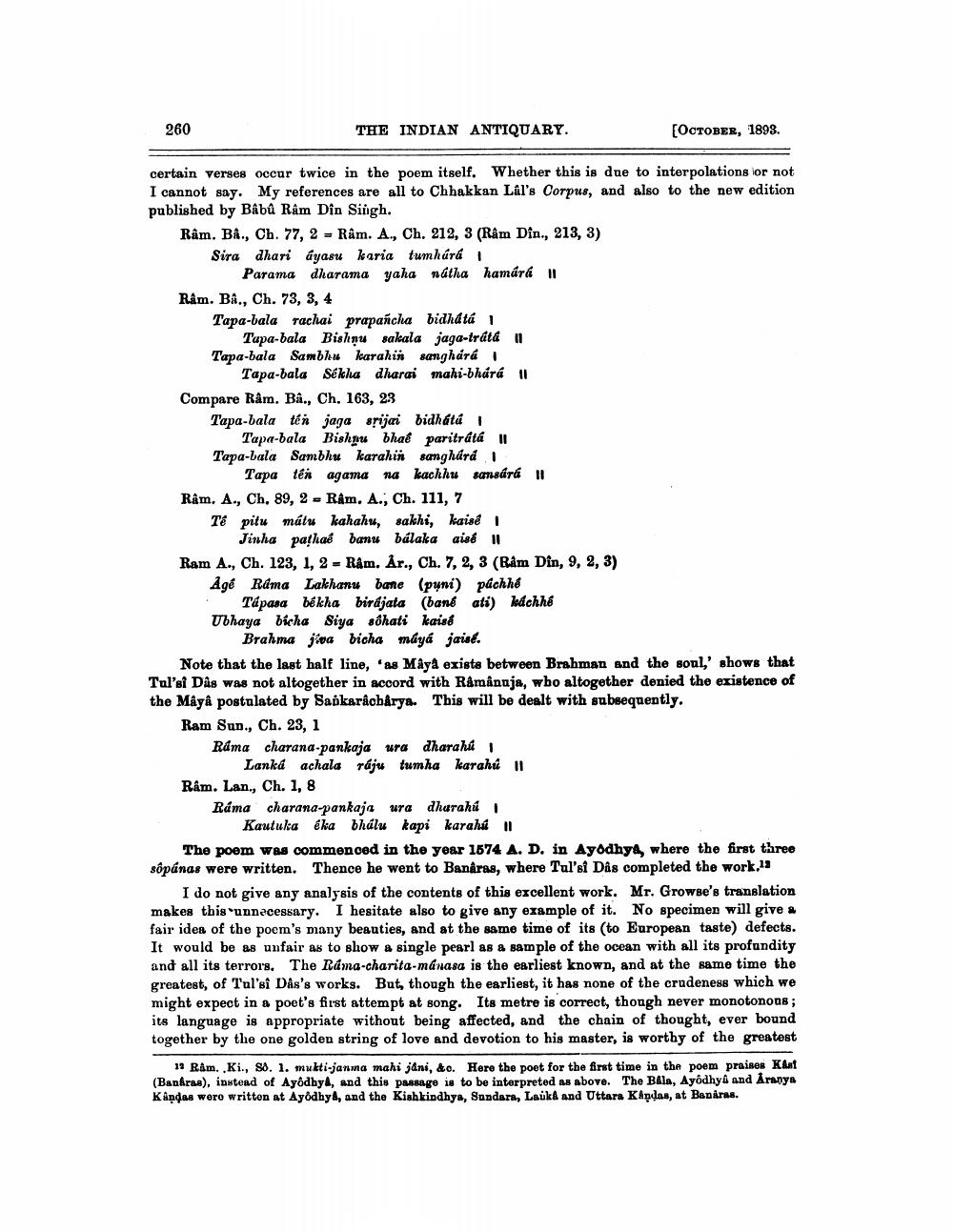________________
260
THE INDIAN ANTIQUARY.
[OCTOBER, 1893.
certain verses occur twice in the poem itself. Whether this is due to interpolations or not I cannot say. My references are all to Chhakkan Lal's Corpus, and also to the new edition published by Bâbî Râm Din Singh. Râm. Bả, Ch. 77, 2 = Râm. A, Ch. 212, 3 (Ram Dina, 213, 3) Sira dhari ayasu karia tumhára
Parama dharama yaha nátha hamárk II Râm. Ba., Ch. 73, 3, 4 Tapa-bala rachai prapancha bidhátá
Tapa-bala Bishnu sakala jaga-tráta 11 Tapa-bala Sambhu karahin sanghará
Tapa-bala Sekha dharai maki-bhára !! Compare Râm. Bå., Ch. 163, 23 Tapa-bala tén jaga srijai bidhátú
Tapa-bala Bishnu bhal paritráta | Tapa-bala Sambhu karahin sanghård1
Tapa tên agama na kachhu sansára !! Râm. A., Ch. 89, 2 = Râm. A., Ch. 111, 7 Té pitu mátu kahahu, sakhi, kaise
Jinha pathae banu bálaka aisé !! Ram A., Ch. 123, 1, 2 – Râm. Ar., Ch. 7, 2, 3 (Ram Dân, 9, 2, 3) Age Rama Lakhanu bane (puni) pachh&
Tápasa békha birajata (bant ati) ldchhe Ubhaya bícha Siya sohati kais&
bichar maryatinio
Talat be that the last bila
Note that the last half line, 'as Maya exists between Brahman and the soul,' shows that Tulsi Das was not altogether in accord with Ramanuja, wbo altogether denied the existence of the Mâyâ postulated by Saokarácbårya. This will be dealt with subsequently. Ram Sun., Ch. 23, 1 Ráma charana-pankaja ura dharahú
Lanká achala ráju tumha karahú 11 Râm. Lan, Ch. 1, 8 Ráma charana-pankaja ura dharahú
Kautuka éka bhálu kapi karahú 11 The poem was commenced in the year 1574 A. D. in Ayodhyd, where the first three sôpánas were written. Thence he went to Banaras, where Tul'si Das completed the work.13
I do not give any analysis of the contents of this excellent work. Mr. Growse's translation makes this unnecessary. I hesitate also to give any example of it. No specimen will gives fair idea of the poem's many beauties, and at the same time of its (to European taste) defects. It would be as unfair as to show a single pearl as a sample of the ocean with all its profundity and all its terrors. The Rama-charita-mánasa is the earliest known, and at the same time the greatest, of Tulsi Das's works. But, though the earliest, it has none of the crudeness which we might expect in a poet's first attempt at song. Its metre is correct, though never monotonous; its language is appropriate without being affected, and the chain of thought, ever bound together by the one golden string of love and devotion to his master, is worthy of the greatest
19 Ram..Ki., So. 1. mukti-janna mahi jani, &o. Here the poet for the first time in the poem praises Kaut (Banfras), instead of Ayodhya, and this passage is to be interpreted as above. The Blla, Ayodhya and Aranya Kandas wero writton at Ayodhy A, and the Kishkindhya, Sundara, Laika and Uttara Kapuas, at Banaras.




